Battle of Barnet 1471
The early morning fog of Easter Sunday 14th April 1471 was a pivotal moment in the Wars of the Roses. The Battle raged five miles up the road but the Suburb lands were in the thick of it. King Edward IV’s forces, said to have numbered 9000, included two further monarchs, the future King Richard III and, as hostage, an enfeebled King Henry VI. All passed the Suburb’s eastern border in the evening of Saturday 13th April 1471. Within 24 hours some of those fleeing the conflict, the Yorkist victors, casualties and vanquished foes all were passing by on the way to the City.
This article, by Suburb resident Lester Hillman, traces the route taken by Edward’s army from the Priory to the battlefield at Barnet
The Wars of the Roses at the Priory doorstep - a 550th anniversary
Roses Round the Door
Lester Hillman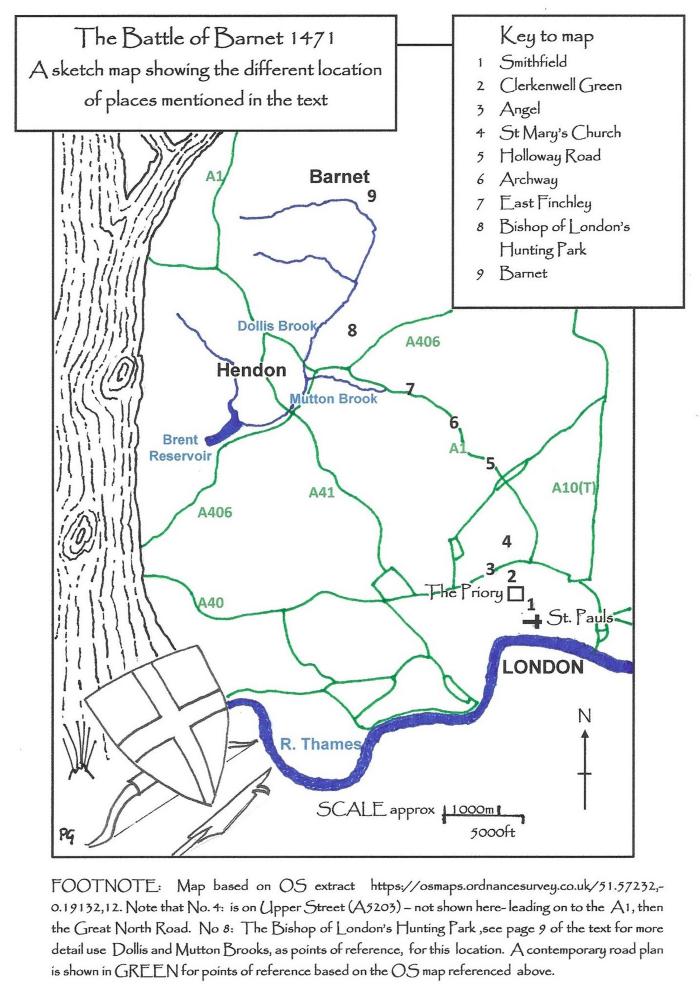 Introduction
Introduction
At the end of today’s London Underground Northern Line a ‘Zone 5’ medieval battle took place on Easter Sunday 14th April 1471. Ten miles North of the St John’s Clerkenwell Priory the Battle of Barnet in the ‘Wars of the Roses’ or ‘The Cousins War’ had far reaching consequences for England, the Tudors and for the Order of St John.
To what extent was the Order involved? There were colourful characters, pivotal moments and elements of chance, drama and tragedy. Contemporary witnesses and place names add to the story. Much of the drama played out on the doorstep of the Clerkenwell Priory. The forces of Edward IV gathered at St John’s Field. Victors and vanquished returned there. Prior John Langstrother was a casualty of the Spring 1471 conflicts, he was executed in Gloucester after the battle of Tewkesbury and his body was bought back to Clerkenwell for burial.
1471 - 2021
The 550th anniversary of the Battle of Barnet offers a focus for wider public interest and engagement with a chance for new questions to be posed and insights gained.
This note traces the route taken by Edward’s army from the Priory to the battlefield at Barnet. Along the way echoes of the battle are discovered and explored. Matching a fifteenth century pace calls for six or seven hours. However today, from Highbury Corner a couple of miles up the route, the 263 bus route can hasten a battlefield deployment. High Barnet, at the end of the Underground Northern Line, offers yet swifter passage to the medieval front line. Alternatively, picking up the 234 bus at East Finchley and going via Muswell Hill to Colney Hatch Lane and Friern Barnet Lane follows an easterly and an historic route.
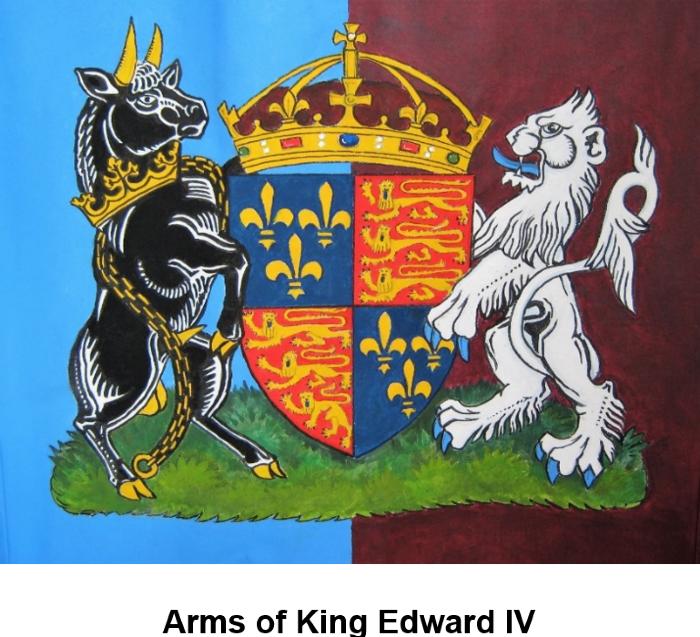
It is surprising how quickly everything seems to have happened that Easter weekend in 1471. Edward IV’s arrival in London, the resolving of London’s loyalty, the army forming up, getting the force to Barnet, the battle and return, all within a long weekend. Edward’s experienced opponent, the Earl of Warwick, seems to have been wrong footed, judging Edward would have remained in London until after the Easter commemorations.
Saturday afternoon 13th April 1471 presented a vivid and frenetic scene outside the Priory. Edward’s Yorkist army formed up at St John’s Field. Perhaps his force numbered 9,000, estimates vary widely, maybe 400 did not survive to return. With varied loyalties distinct groupings would have been evident. Combatants with specialist artillery skills had been drawn from abroad. Horses and equipment would be evident. Preparation would have been hasty but there would be signs of logistic support. London’s loyalties had swung to and fro, days before, now livery companies could not risk being seen unenthusiastic. Provisioning, weapons, transport, fuel, ale, painted banners, music, gambling, distractions, entertainment, spiritual welfare, reassurance in health care and family support all would have a place. Veterans, children, onlookers, chroniclers and perhaps spies would have mingled with locals. There would be excitement with expectations of casual work and a share of the spoils. Businesses, institutions and residents would be keeping a watchful eye to minimise local damage and things going missing.
The centuries-old Priory military commissariat could hardly have been more visible. But in the midst of a Yorkist army the Order had a problem. John Langstrother the Prior was away and more to the point his loyalties were with the Lancastrian cause. He would shortly be landing at Weymouth with Henry VI’s Queen, Margaret of Anjou, and the Lancastrian heir Edward Prince of Wales.
At around 4pm on 13th April 1471 Edward IV and ‘a great armye’ set off from Smithfield on the journey of more than 10 miles. There was a stop around 4 miles out at Highgate and then a slog up to Barnet arriving when “It was right dark”.
Clerkenwell Green - The Three Kings 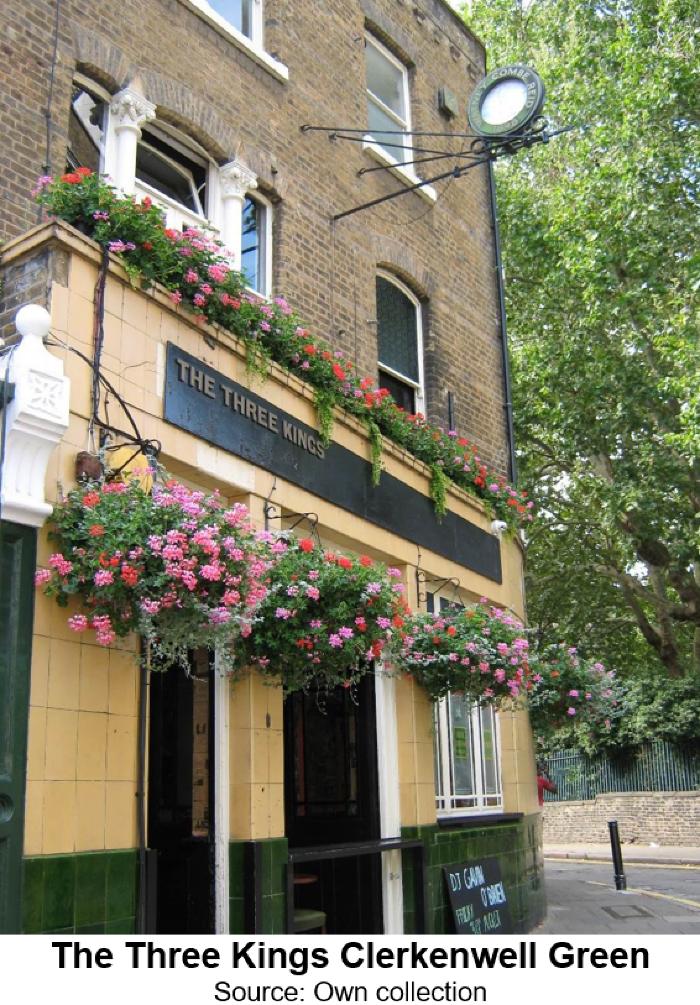
Today ‘The Three Kings’ tavern nestles in an ancient enclave in the shadow of St James Church by Clerkenwell Green.
‘Three Kings’ did assemble near here on 13th April 1471. They were very different, only one would have passed a recruitment fitness medical test. Whilst all survived Barnet they would meet their ends in contrasting ways. King Edward IV the 29 year-old Yorkist stood 6’ 4” and had an imposing presence. He was to die in his bed in 1483 having reigned for 12 years. Edward bought along, as a hostage, the Lancastrian Henry VI. When his father Henry V died in 1422 he had been a nine-month old baby. Now 49, a catatonic schizophrenic, his enfeebled state made him appear more like 70. In less than six weeks he would be murdered in the Tower of London. The third was eighteen-year old Richard Duke of Gloucester, brother and ally to Edward IV. He would later become King Richard III. At 5’ 8” his stature may have been slightly diminished by a congenital spinal deformity. At Bosworth, 22nd August 1485 he would become the last English King to die on a battlefield. His body was lost for five centuries until his spectacular rediscovery just 100 paces from Leicester Cathedral, announced 4th February 2013. His remains were reinterred in the Cathedral and there is today a new dedicated Museum adjacent.
Where the army and three kings formed up stands ‘The Three Kings’ public house, celebrated until recently with a sign in graphic detail. Whilst it would be nice to think the pub has borne its name down through five centuries alas closer inspection revealed the three kings to be King Kong, King Elvis and King Henry VIII.
Nearly a century before the ‘Three Kings’ gathered, another King and his realm balanced on the knife edge at Clerkenwell Green. On Saturday 15th June 1381, the fourteen-year-old King Richard II confronted Wat Tyler in the Peasant’s Revolt. The day before Robert Hales, the Prior of England had been executed at Tower Hill. Three decades on from 1381 youthful belligerents from Clerkenwell Green may have been experienced veterans at Agincourt in 1415.
Angel - The Generation Game
Edward and Warwick would have been particularly keen to be on the side of the angels, especially with a conflict looming at Easter 1471. Passing through what is the ‘Angel’ area today might have focused minds. The name may have been prompted by the property interests of religious houses and their water control points in the vicinity plus a well positioned inn on the drover route to Smithfield.
The conflict of Spring 1471 offers evidence of generational links in the warfare business. At the Battle of Tewkesbury, three weeks after the Battle of Barnet, Prior John Langstrother was with Sir John Wenlock. A veteran of Agincourt fifty-six years earlier. Wenlock was killed, possibly a casualty of his own side. As with Robert Hales, being Prior of The Order of St. John at Clerkenwell carried risk as crowns changed to different heads
Warfare as a generational family business offered an attractive even honourable profession. Fixtures were generally sympathetic to agricultural calendars with opportunities for travel, mercenary pay and spoils. Edward had landed at Ravenspur at the mouth of the Humber on the 14th March 1471. Arriving from Flushing his force numbered 1200 in 36 ships. A proven record of survival on battlefields would be reassuring to compatriots. In the ‘War of Cousins’ payment might have ensured loyalty more than kinship. Nevertheless families and close kinship groups might offer confidence in extremis. Artillery needed specialist skills, equipment was expensive, complicated and heavy. Barnet has a claim to be the first battle on English soil where firearms featured significantly.
Gerhard von Wesel offered a contemporary perspective and one that might have been fairly neutral. He referred to specialist mercenaries ‘three hundred of Flemmynges with hande-gonnes’. Elsewhere there are observations of 500 Flemish gunners ‘black and smoky’. He was a merchant and the son of Hermann a merchant from Cologne. He lived in the Steelyard, the Hanseatic enclave on the Thames, where Cannon Street Station is today.
St Mary’s - Upper Street and Richard Cloudesley
About an hour into the march to Barnet the troops would have been passing the Church of St Mary, a place of worship first recorded in the 12th century. Perhaps those passing received a hasty blessing and some refreshment. With its ancient churchyard it still sits on today’s Upper Street. Prominent close by is the tomb of Richard Cloudesley. He died 1517/1518 but more than five centuries on his generous benefactions continue to deliver remarkable support to local charities.
Born 1467 or 1469 he would have been a very small child in 1471. With a home near the Hermitage Chapel at Highgate his family seem to have had interests stretching along Edward’s line of march. Cloudesley became a prominent figure in Islington. There were brushes with violence and he was appointed a Constable to Islington with links to enforcement. Did he get a taste from observing the dramas of April 1471 on his doorstep?
Holloway Road - Arsenal playing at home?
From Highbury Corner many Saturday afternoons see the Holloway Road re-enacting the march to battle of Saturday 13th April 1471. Thousands of people, mainly men sporting red and white, the colours of the Wars of the Roses, stride purposefully to the Arsenal Stadium. A sense of fierce loyalty is palpable with tight knit groups and passionate anticipation for the orchestrated drama.
It is interesting to imagine how the force moved and order was maintained. Four abreast it would take perhaps three hours for a force of 9000 to pass a given point. There would be halts and stoppages, wagon mishaps, fatigue and injury, St John First Aiders would have been useful, then just as they are today, at the Arsenal.
Archway- Great uncle Richard (seventeen generations on)
With the prospect of refreshments at the Bishop of London’s Hunting Park, atop Highgate at ‘Hornsey Park’, the eighteen-year old Duke of Gloucester, future King Richard III, led his forces through Upper Holloway and Archway. More than five centuries on Michael Ibsen, Richard III’s seventeen times great nephew has a cabinet making workshop in Marlborough Road, Upper Holloway. This Canadian born descendent had been quietly valuing the anonymity of Archway until the discovery of the bones in the Leicester car park. His DNA helped corroborate Richard’s identity. From his one-man business, established more than 30 years ago, the caskets for Richard III’s re-interment were fashioned. Ibsen was present for the Service in Leicester on Thursday 26th March 2015 and contributed to the broadcasts.
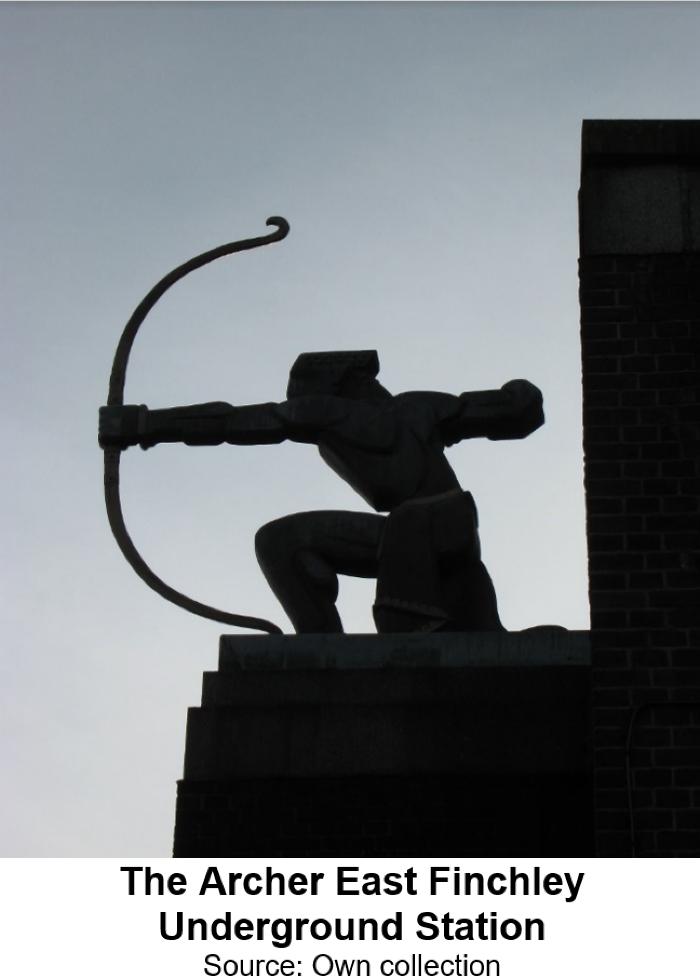 East Finchley - Victualling the army
East Finchley - Victualling the army 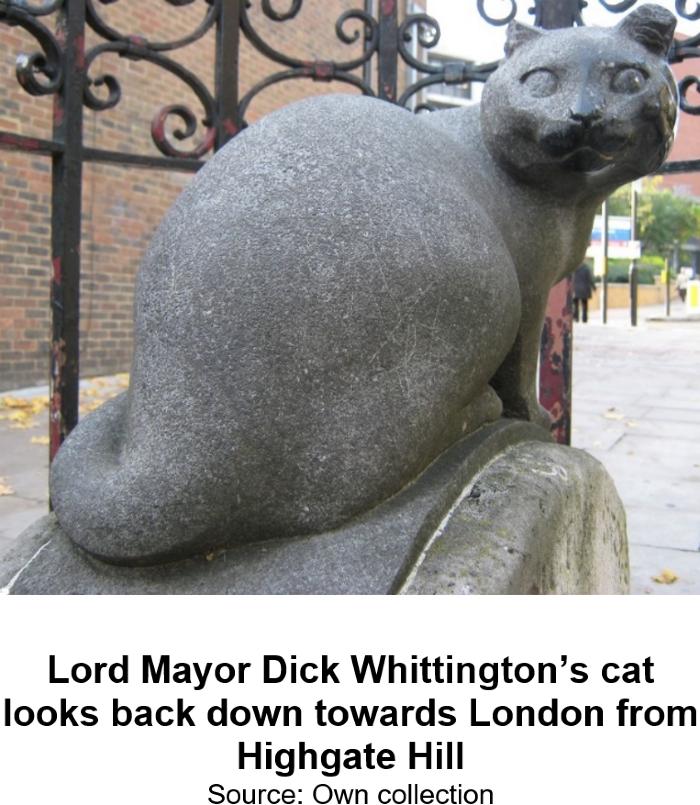
(Some 10,000 arrows may have been recovered from the battlefield) Climbing up to Highgate there is a Whittington stone and several place names commemorate Lord Mayor Dick Whittington. Rhyme, legend and pantomime tell us he was no stranger to the route from the City of London. Whittington Lord Mayor in the early fifteenth century would have just been in living memory. He had been a prominent funder of military campaigns. He was a Mercer and the City’s Worshipful Livery Companies would have been a natural port of call to fund and provision Edward IV’s army.
Around 7pm Edward’s army seems to have had an opportunity for refreshment in the Park. The Hunting Lodge was in the centre of today’s Highgate Golf Course. Whilst the Park was in decline it might still have been a locality with useful practical skills for camping in the field and animal handling. The Bishop of London Thomas Kempe does not feature prominently at this time, nor on the Yorkist side. Lancastrian Henry VI was housed in his London Palace. It was the Archbishop of York, George Neville, who took the lead in London rallying the Lancastrian cause. However, Neville then switched sides 10th April 1471. Yet the Bishop of London was a survivor. Kempe was in post from 21st August 1448 to 28th March 1489, through the reigns of Edwards IV, V, Richard III and comfortably post Bosworth into Lancastrian Henry VII’s. reign.
Northwards from Highgate the route may have been via Muswell Hill, ‘Mus well’, threading a path between the Dollis and Pymmes Brooks, with ground sloping away either side. Colney Hatch Lane becomes Friern Barnet Lane and then rejoins the High Road South of Whetstone. The Park might have been attractive, commandeered as a quarter- mastering facility, convenient for casualties, prisoner handling, equipment storage, weapons repair and issue, drawing upon local skills from the Park’s better days. Twelve years later, near the end of his short lived reign, Edward V came to Hornsey Park 4th May 1483, Rogation Sunday, to be met by the Lord Mayor and five hundred citizens. By 19th May he was in the Tower, one of the ‘Princes in the Tower’, and a short lived reign before Richard III.
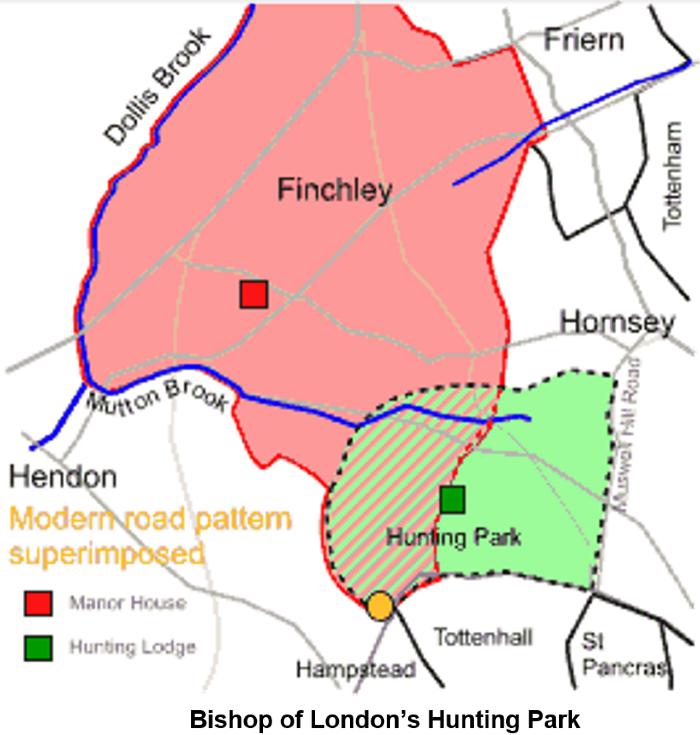 Whetstone- Arriving at the sharp end.
Whetstone- Arriving at the sharp end.
The final approach to Barnet at ‘Whetstone’ conjures up images of a sharpening of weapons and a place name too good to be true. The likelihood is it was an area of confusion, with darkness and uncertainty worsened by skirmishing and harassment from Warwick’s forces. Placing munitions in the right place and clearing obstacles would have been prudent battlefield management. Orders groups would be convened. There would be briefings and instruction, not least to ensure friend and foe were distinguished in this ‘Cousins War’. To bolster loyalty awards might be intimated and titles elevated with hastily decorated and improvised banners. Attention would be focused on discipline and keeping up morale. Enforcing quiet and maintaining a black out seems to have worked, confounding Warwick’s artillery bombardment. There would have been a look out for any slinking away, deserters and spies.
In those last hours before the Easter dawn counselling and the hearing of confessions would surely have been in demand. The Order at Clerkenwell was a place for pensioners and veterans of foreign engagements. Perhaps lay members with direct experience of the Holy Land offered a sympathetic ear, a sort of Ellis Peter’s ‘Cadfael’.
Arraigning the force in order and discouraging lingering in the town of Barnet and its taverns was an objective as much for Warwick earlier in the day as Edward. In the febrile atmosphere fights, grudges, jealousy and misunderstandings would have had to be held in check within each force. To all this must be added attempts at providing the most basic of sustenance and shelter for the thousands of men augmented by a stoical camp following, teams with support skills and the simply curious.
St John’s on the battlefield
How far did St John’s Priory and its community feature in the Battle of Barnet? Friern Barnet was an area in which the Order had property interests. The Manor of Whetstone / Friern Barnet was granted to the Hospitallers in 1199. ‘Friern’ signifies ‘belonging to the brothers’ and the coat of arms crest of the former local authority featured the link.
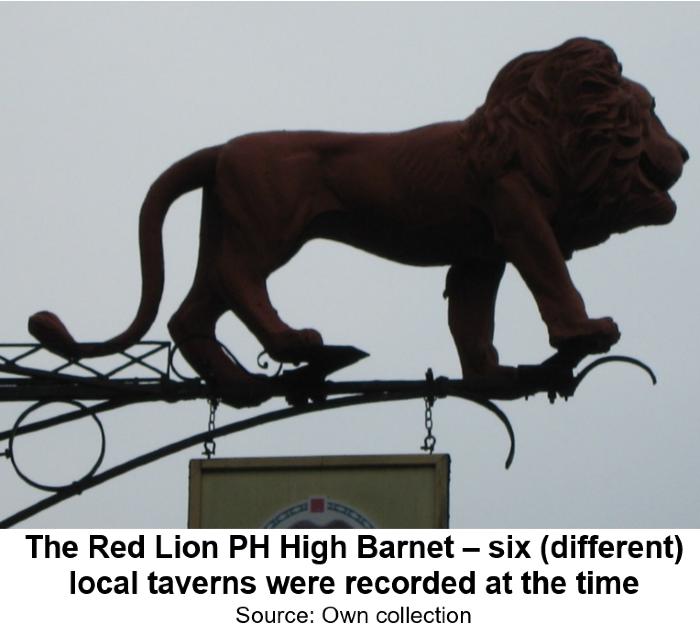
The Church of St John the Baptist Chipping Barnet is ten minutes or so from the battlefield site as presently identified. Its dedication is one shared with the Order of St John. As a significant and secure presence the Church would surely have offered a natural sanctuary for care of the wounded and dying. Today St John’s Ambulance offers first aid to medieval fairs, processions and enactments centred on Barnet. It features in lectures and events. Thus an institution with a likely presence 550 years ago has a continuing and valued role today.
Casualties and those captured would have attracted the eye of the heralds and others in the murky areas of identification, ransom, spoils and booty. Along the line of march the forces would have passed close to Kentish Town and the estate of England’s premier heralds. For most of the fifteenth century the families of Garter Kings of Arms William Bruges and his son in law John Smert were linked to St Pancras Old Church. Earlier in the fifteenth century King Sigismund, a future Holy Roman Emperor, had attended a feast at Bruges home as part of post Agincourt peace negotiations.
Fog of War
‘A man might not see profitably before his own hand’. The Battle of Barnet pivoted very much on a surprise fog in the early morning of Easter Sunday 14th April 1471, a ‘greate myste’ conjured up by Friar Bungay, ‘barabbarara, Santhinoa, Foggibus increscebo, confusio Garabbora, vapor et mistes”, on Gladsmuir Heath ‘Grey Moor'. Gladsmuir is the name of a local road. Artillery bombardment in the night, particularly from Warwick’s side, may have exacerbated the mist.
Soon after the conflict began a rout of the left flank of Edward’s force meant early reports arrived in London of Edward’s defeat. The battle was likely over by noon and news of the true outcome would have reached London later in the day. St John’s Field and the area around the Clerkenwell Priory would have had a role in the return from the battle. Glowing tributes to the victor would follow later.
“Of a more famous knight I never rad syn the tyme of Arturs dayes; he that loveth hymn not, I holde hymn mad”.
“the king manly vigorously and valiantly assailed the enemy in the midst of the strongest of their battle where he with great violence beat and bore down before him all that stood in his way and then turned to the range first on that one hand and then on that other hand so beat and bear them down that nothing might stand in the sight of him”
The bodies of the Earl of Warwick and his brother Sir John Neville Earl Montague were brought to London 7am on Easter Monday. For two days they were exhibited at St Paul’s Cathedral.
Gerhard von Wesel (mentioned above) indicated the fog was widespread in London. He also offers a hint at aftermath reprisals and retribution which may have been witnessed at Smithfield ‘those who went out with good horses and sound bodies bought home sorry nags and bandaged faces without noses’.
Prior John Langstrother returns
Just as the Battle of Barnet was being fought Prior Langstrother landed at Weymouth on the South coast. The seventeen ships carried members of the Lancastrian house, troops and funds. The news reached Edward at his victory feast in Westminster Tuesday 16th April 1471. The two sides then headed for the West Country, Edward stopping over at Windsor for the Feast of St George and no doubt a chance to give thanks in St George’s Chapel to England’s warrior saint. The Battle of Tewkesbury took place on 4th May 1471 with Lord Wenlock and Langstrother at the heart of the Lancastrian force. Following the Lancastrian defeat the Prior was executed two days later in Tewkesbury Market Place, 6th May 1471. His body was allowed to be returned for burial at the Clerkenwell Priory, perhaps still there under the crypt.
In the aftermath of the two battles Henry VI, imprisoned in the Tower of London and no longer a bargaining asset, was murdered at his prayers 21st May 1471. Each year on the anniversary a Service takes place in the Wakefield Tower.
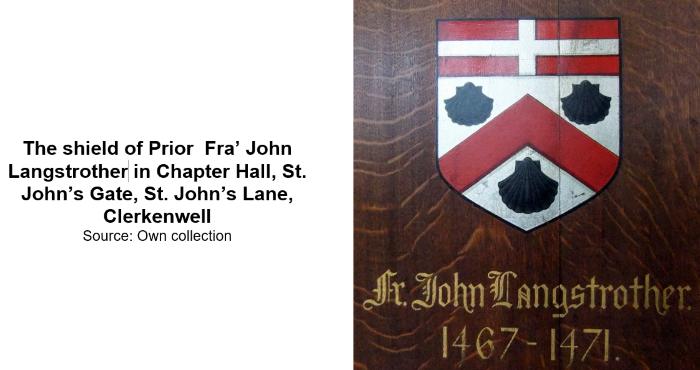 Revisiting the Battle – Shakespeare’s take
Revisiting the Battle – Shakespeare’s take
A Shakespeare league table might place Henry VI at the top. No less than three plays are devoted to him. The bard famously addresses one further play to Richard III but Edward IV, victor of the Battle of Barnet, must content himself with a walk on part in Henry VI Part III.
The Battle of Barnet closes Shakespeare’s Henry VI’s trilogy. A century after the conflict William Shakespeare himself may have attended upon Edmund Tylney the Master of the Revels, at St. John’s Gate. The censor’s approval for a play, dwelling so dramatically upon the fortunes of a Tudor monarch, would have been particularly sensitive. More than 10% of Henry VI Part III explores the turmoil of Spring 1471. Thus the former Priory might well have hosted the first offering of the bard’s Barnet drama. The Master of the Revels would also have kept an eye on commissions to the nearby theatre support industries - properties, costumes, sets and decoration.
Henry VI Part III Act V Scene I - Warwick in Coventry declares
“I will away towards Barnet presently and bid thee battle, Edward if thou dar’st”
Edward replies
“Yes Warwick, Edward dares and leads the way Lords, to the field; Saint George and victory”.
In Scene II – A Field of Battle near Barnet, Warwick wounded and captured, expires
“For Warwick bids you all farewell”, whereupon his body is carried off.
Scene III - Another Part of the Field sees Edward off to Tewkesbury
“We have now the best at Barnet field…..Strike up the drum! Cry Courage! And away.”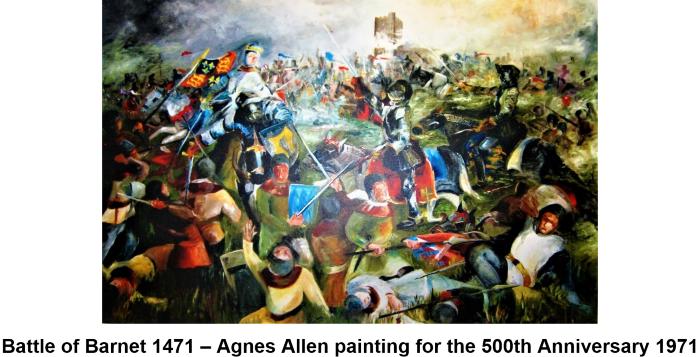 Acknowledgements
Acknowledgements
The support, encouragement, advice, facilities or texts of the following are gratefully acknowledged.
The Museum of the Order of St John, Archive, Library, staff and volunteers. The St John Historical Society, Paul Gwilliam, Terry Walton, Pamela Willis, St John Ambulance, Her Majesty’s Palace and Fortress, Tower of London, Historic Royal Palaces, Ghent University Library, Transport for London, City of London Corporation, Guildhall, Barbican & Shoe Lane Libraries, London Metropolitan Archive, Farringdon Ward Club, London Borough of Islington, Clerkenwell & Islington Guides Association, Islington Archaeology & History Society, Andrew Gardner, The Three Kings PH, St Mary’s Church Upper Street, Stuart Low Trust, Clerkenwell & Islington Guides Association, Jenny Watson Bore, We Are Ageing Better UK, Jess Grieve, St Pancras Old Church, Peter Barber OBE former Keeper of Maps British Library, Malcolm Stokes, Hornsey Historical Society, Leicester Mercury, Leicester City Council, Islington Tribune, Sunday Telegraph, Evening Standard, Metro, North London University of the Third Age, John Hajdu, National Trust Barnet Association, Patricia Meadows, St John the Baptist Church Chipping Barnet, Agnes Allen, Barnet Museum & Local History Society, Paul Baker, Battle of Barnet Project, Barnet 1471 Battlefields Society, Margaret Luck, Barnet Medieval Festival Committee, Susan Skedd & William Shakespeare
FRONT COVER: Battle of Barnet Historie of the Arrival of Edward IV Ghent University Library MS 236 f 2r

 It is surprising how quickly everything seems to have happened that Easter weekend in 1471. Edward IV’s arrival in London, the resolving of London’s loyalty, the army forming up, getting the force to Barnet, the battle and return, all within a long weekend. Edward’s experienced opponent, the Earl of Warwick, seems to have been wrong footed, judging Edward would have remained in London until after the Easter commemorations.
It is surprising how quickly everything seems to have happened that Easter weekend in 1471. Edward IV’s arrival in London, the resolving of London’s loyalty, the army forming up, getting the force to Barnet, the battle and return, all within a long weekend. Edward’s experienced opponent, the Earl of Warwick, seems to have been wrong footed, judging Edward would have remained in London until after the Easter commemorations.  Today ‘The Three Kings’ tavern nestles in an ancient enclave in the shadow of St James Church by Clerkenwell Green.
Today ‘The Three Kings’ tavern nestles in an ancient enclave in the shadow of St James Church by Clerkenwell Green.  East Finchley - Victualling the army
East Finchley - Victualling the army  (Some 10,000 arrows may have been recovered from the battlefield) Climbing up to Highgate there is a Whittington stone and several place names commemorate Lord Mayor Dick Whittington. Rhyme, legend and pantomime tell us he was no stranger to the route from the City of London. Whittington Lord Mayor in the early fifteenth century would have just been in living memory. He had been a prominent funder of military campaigns. He was a Mercer and the City’s Worshipful Livery Companies would have been a natural port of call to fund and provision Edward IV’s army.
(Some 10,000 arrows may have been recovered from the battlefield) Climbing up to Highgate there is a Whittington stone and several place names commemorate Lord Mayor Dick Whittington. Rhyme, legend and pantomime tell us he was no stranger to the route from the City of London. Whittington Lord Mayor in the early fifteenth century would have just been in living memory. He had been a prominent funder of military campaigns. He was a Mercer and the City’s Worshipful Livery Companies would have been a natural port of call to fund and provision Edward IV’s army.  Whetstone- Arriving at the sharp end.
Whetstone- Arriving at the sharp end.  The Church of St John the Baptist Chipping Barnet is ten minutes or so from the battlefield site as presently identified. Its dedication is one shared with the Order of St John. As a significant and secure presence the Church would surely have offered a natural sanctuary for care of the wounded and dying. Today St John’s Ambulance offers first aid to medieval fairs, processions and enactments centred on Barnet. It features in lectures and events. Thus an institution with a likely presence 550 years ago has a continuing and valued role today.
The Church of St John the Baptist Chipping Barnet is ten minutes or so from the battlefield site as presently identified. Its dedication is one shared with the Order of St John. As a significant and secure presence the Church would surely have offered a natural sanctuary for care of the wounded and dying. Today St John’s Ambulance offers first aid to medieval fairs, processions and enactments centred on Barnet. It features in lectures and events. Thus an institution with a likely presence 550 years ago has a continuing and valued role today.
